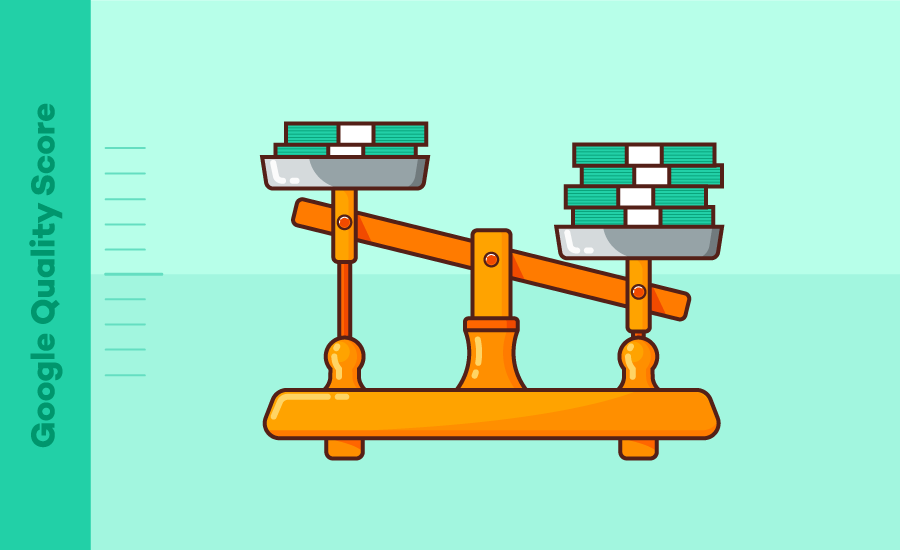Of course you’ve considered the quality of your Google Ads campaigns. The quality of the ads, keywords, ad copy, every element and minute detail you could think of involved with the campaign. But have you given any thought to the quality score Google will actually give you?
What does Google mean by quality score? And how is it determined? We provide some of the answers below, along with how you can improve a low-ranking status.
What is quality score?
Quality score is an estimate of the quality of your ads, keywords and landing pages. It gives you insight into how well your ads are performing on a scale of 1-10.
Your Google Ads quality score is an aggregated estimate of your overall performance in ad auctions which means it’s not used to determine your ad rank at auction time. Auction-specific quality is calculated by click-through rate, ad relevance, and landing page experience to determine ad rank in real-time.
Why should you care about your quality score?
A high quality score can lower your cost-per-click (CPC) and cost per conversion, plus increase your return on investment (ROI). Scores higher than 5 mean that Google has determined that your CPC meets your potential customers’ needs. The better you are at this, the less Google charges you for ad clicks.
Rankings higher than five earn a discount on their CPC and rankings lower than five pay a percentage increase in price. So with a higher score, you’re earning a higher ad placement for a lower cost which is gaining more exposure and a higher conversion rate.
Your eligibility for ad extensions and other ad formats also increases with the growth of your quality score. Ad extensions provide additional information for your ads and allow potential customers to take action directly from search results.
Factors the determine quality score
There are three main factors that determine your Google Ads quality score: expected click-through rates, ad relevance and landing page experience.
Expected click-through rate is the likelihood that your ad will be clicked. The historical click-through rate of both the keyword and the matched ad, as well as the historical click-through rate of the entire Ads account are considered when calculating this determinant.
Ad relevance refers to how closely your ad matches the intent behind a user’s search. Your keywords also come into play here. Running an ad with copy that uses the keyword related to a user’s search intentions makes it safe to assume you’ll gain a higher quality score.
Landing page quality, relevance and loading time can also adversely affect your quality score if they are not optimized. The quality of your landing page refers to whether it has easy navigation, clear purpose, and links to business information pages. It should also be relevant to your ad, telling the same story that drew customers to click your ad in the first place.
Lastly, half of web users expect a page to load in a maximum of two seconds. If a site hasn’t loaded within three, users tend to abandon the site altogether. It’s important to ensure that your page is loading as fast as possible to keep viewers locked into it.
How to check your quality score
You can find your quality score by clicking the white speech bubble next to any keyword status in the keywords tab of Google Ads or by enabling the “qual. score” column. By doing this you can also see your ratings for expected click-through rate, ad relevance and landing page experience.
It’s important to note that newly added keywords and low volume keywords will receive a score of null as there is insufficient data to determine quality score. A null score is shown as “—” under the Status column. This is a recent update by Google, as keywords with insufficient data used to receive an average score of six.
How to improve your quality score
When reviewing performance, no one wants to be in the red. Rather everyone wants to be in the green, which in this case means having a Google quality score higher than a five.
There are a few things you can do to move to greener pastures and improve that quality score, however. For starters, only focus on high-value efforts where you can affect change. Being selective allows you to maximize your impact.
You can improve your expected click-through rates by ensuring your ad highlights unique benefits to your product or service. Tell your customers what they’re gaining by going through you rather than a competitor.
Experimenting with different CTAs will also help because it will guarantee you’re using one that will attract more customers. You can nicely wrap all of these things in the package that is the text of your ad. Make it creative and be specific.
Everything just mentioned broadly answers how to improve your ad relevance as well. Write your ad text to match the language of the searcher’s query by speaking more directly to the intent of their search and adding negative keywords you don’t want your ads to appear for. This requires moving keywords to smaller groups with more targeted creatives.
Lastly, improve your landing page experience. Be sure that you’re sending traffic to landing pages that are closely related to the user’s search query, continuing the conversation set up by your ad. You should also use your conversion rate as a proxy for good landing page experience.
Keep in mind that users are frequently searching on their mobile devices rather than their desktops making the ease of navigation a very important factor. A responsive website, or one that’s already formatted for mobile, will keep your customers engaged and more likely to follow through with a conversion.
To higher scores and lower costs
With insight on the key factors to determining your Google Ads quality score, charge ahead and maximize your efforts. Don’t sweat the small stuff that doesn’t make an impact on the larger picture.








